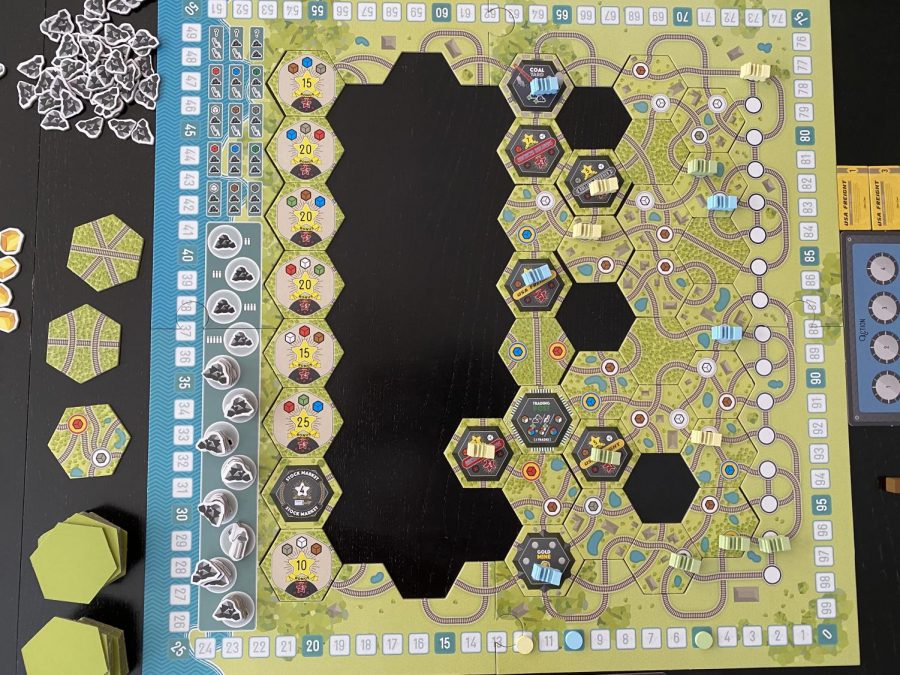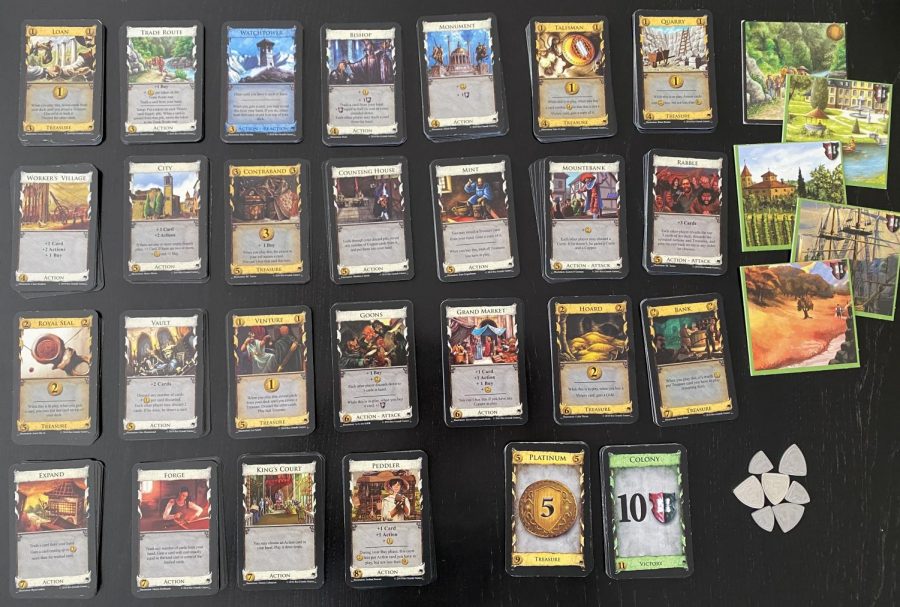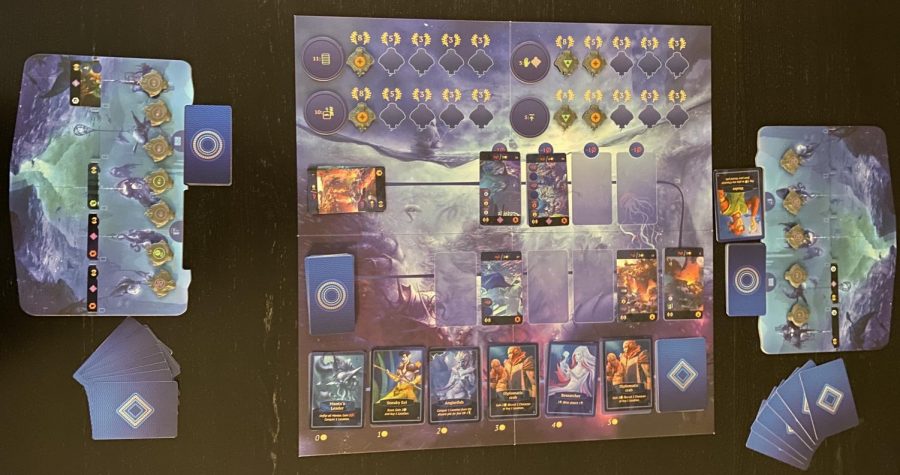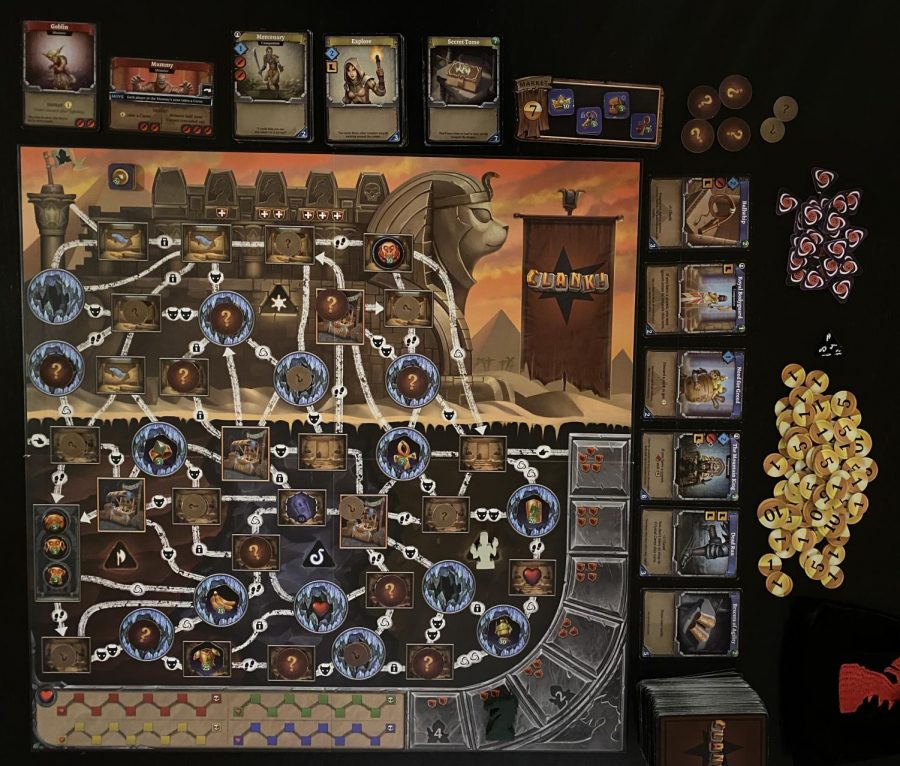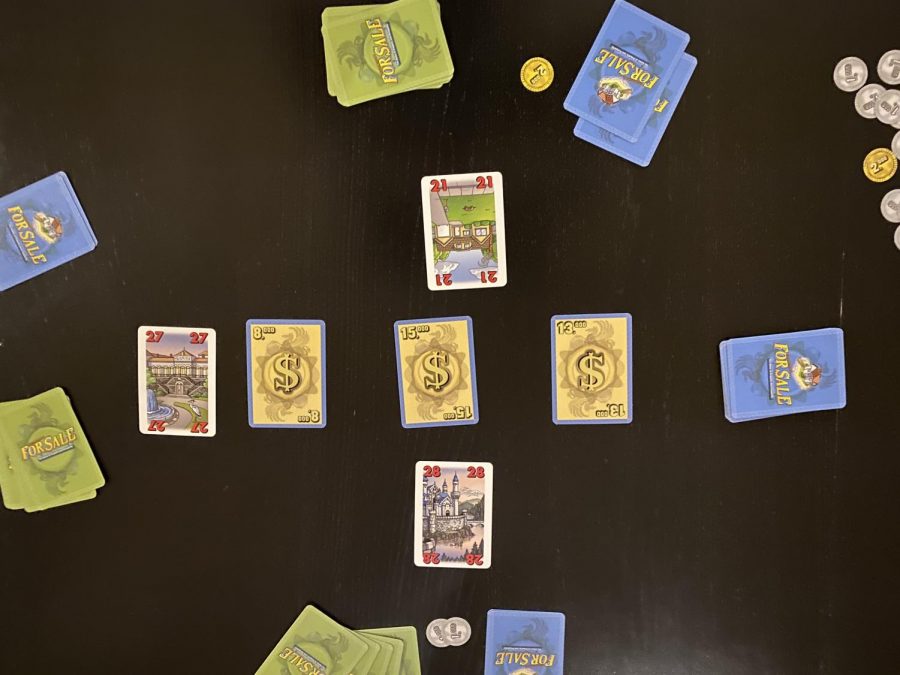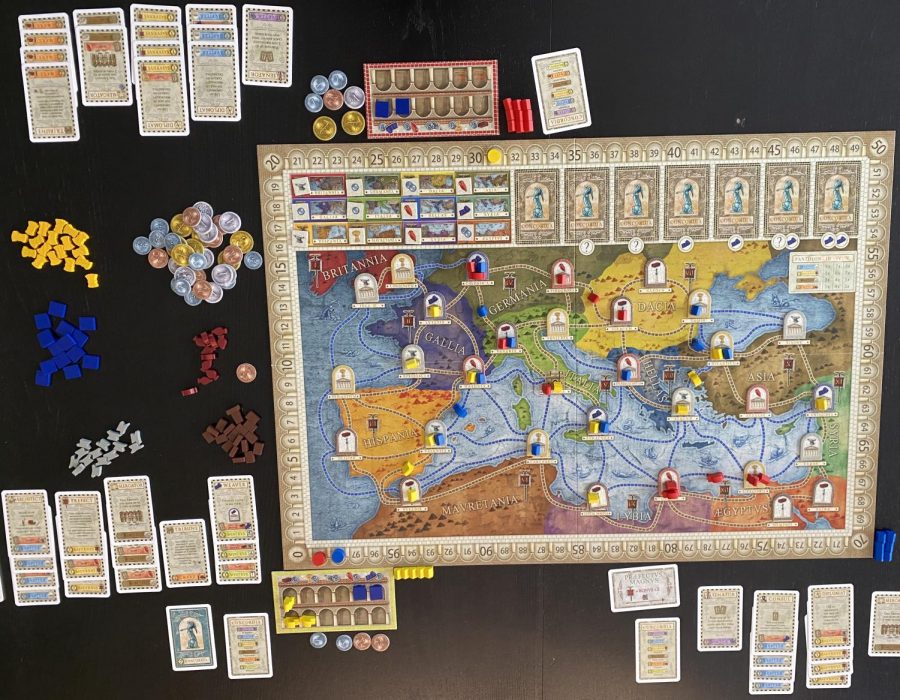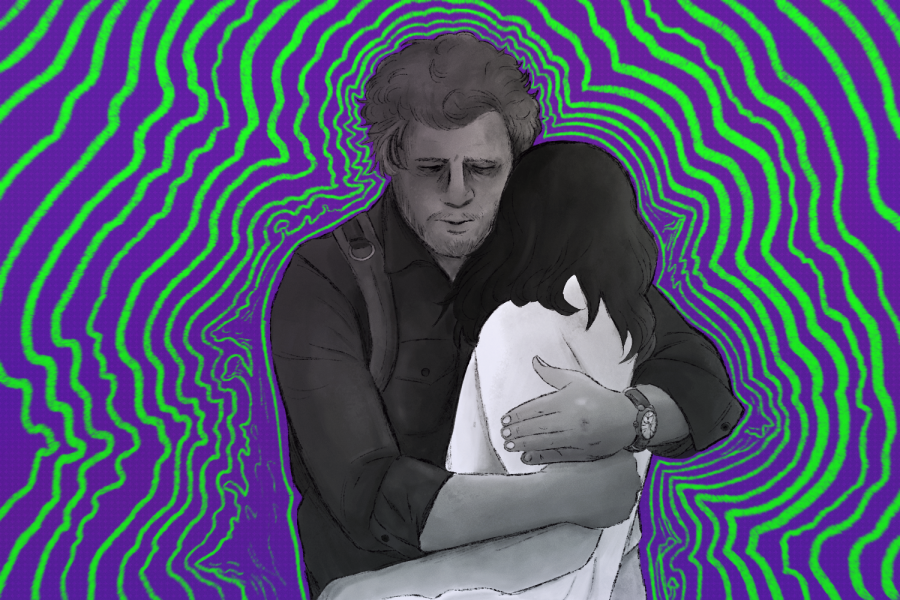You and your rival captains have found a map that leads to riches if you can find hoard buried treasures before your enemies beat you to it. However, you’ll have to recruit the right skill sets and race your ships to the dive sites first.
Deep Blue is a family-weight game that combines engine-building and pushing your luck. The engine-building part comes from playing cards to move ships and get more cards, and later picking up some of the played cards to use again in the future. The “push your luck” aspect is found when players dive for treasure; players will pull gems out of a bag with some gems providing players with points and others threatening to end the dive. This thrilling adventure is a game for two to five players of any experience level and takes no longer than an hour to play. Here’s how it works.
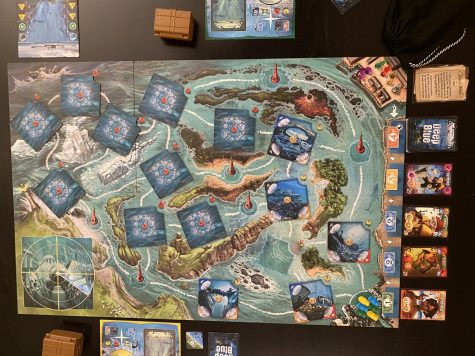
How to Play
Before I get into the specifics of the gameplay, let’s take a look at the game board, set up and shown above. All players have two ships that will start at the harbor in the bottom-right corner of the board. There are various diving sites on the board connected by white lines. The dive sites close to the harbor are face-up, and the ones farther from the harbor are face-down. Furthermore, four of the face-down dive sites are sunken cities, which are important because there are special rules when diving at the sunken cities, and the game ends once a dive takes place at all four of those sites. On the right side of the board, there is also a deck of crew cards that players can recruit, and four cards are always face-up. A diving board is placed near the board to be used when it is time to dive. That board also indicates which gems to place in the bag at the start of the game and which gems to initially set aside.
Each player starts the game with four starting cards and a player board that summarizes the possible actions that players can take. Players that play later in turn order will get compensation tokens that can be cashed in for a resource anytime during the game. In addition, players will get a treasure chest to store victory coins they accumulate during the game.
Now let’s get to the gameplay. Players will take turns taking one of four actions until the end of the game; below is a summary of what the four actions are.
Recruit
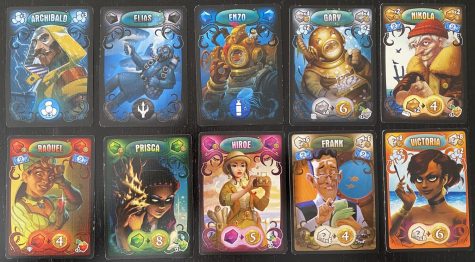
When a player takes the recruit action, they play any number of cards from their hand that have money symbols on the top corners. The total money spent indicates which crew card the player can recruit. The number of dollars needed to recruit a particular card is shown on the game board next to the card. If a player pays four dollars, they discard all the face-up cards, add four new face-up cards from the top of the deck, and recruit any one of those of their choice. After a player takes this action, they put their played cards in their discard pile, the recruited card in their hand, and slide down all remaining crew cards so they get cheaper. A new crew card is flipped face-up to fill up the row back to four cards. Whenever a crew card is revealed, players check the bottom-right corner of it to see if they need to add a certain type of gem to the bag.
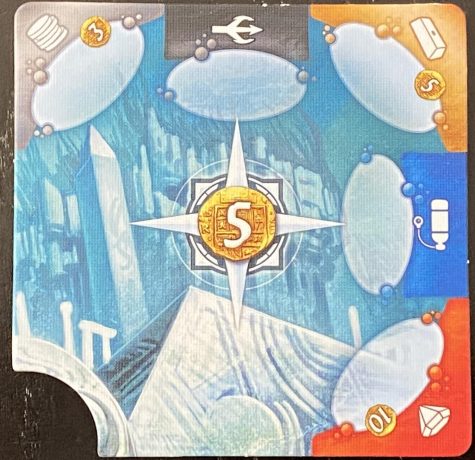
Move
The moving action starts off similar to the recruiting action by a player playing any number of cards from their hand. This time, players play cards with propeller icons at the top and add up how many propellers they have in total. This amount is their total movement, which they can allocate in any combination between their two ships. To move a ship one space, players follow a white line to it to another space. Most spaces are dive sites, but some spaces are buoys. If a player ends a ship’s movement on a face-down dive tile, they flip it over to reveal it. Dive sites have a scouting bonus along the sides of them, and when a player ends any of their ship’s movement on a dive site, they get to place that ship on any of the unoccupied bonus locations. After moving, players place their played cards on their discard pile.
Rest
When players want to get their played cards back, they can rest. When players rest, they shuffle their discard pile and draw three cards from it to add to their hand. The remaining cards are left in the discard pile.
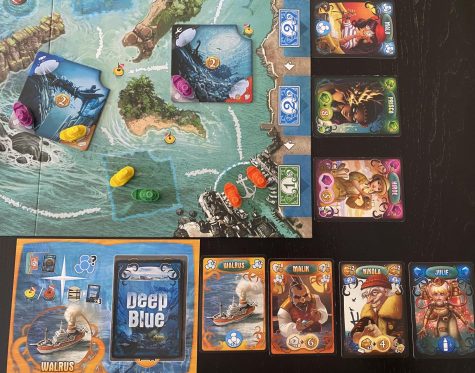
Dive
The last action that a player can take on their turn is dive. When a player dives, they first indicate where the dive will take place, which must be one of the tiles where they have a ship present. Next, all players choose whether they want to rush to the dive sites. Players can move any of their ships exactly one space away from the dive site to the site for free. While this allows the player to participate and potentially earn points in the dive, they do not get to place their ship on a scouting bonus location even if one is unoccupied. Now the dive begins.
During a dive, the dive leader, or player who took the dive action, is in control. They must keep choosing to pull another gem from the bag or to stop pulling gems and end the dive. Many of the gems in the bag are good and reward players with points. Silver, gold, and red gems are worth points to any players who are still in the dive when it ends. In addition, players can always play cards from their hand during the dive when certain criteria are met. For example, if the sixth gem pulled during a dive is the first gold one, a player can play a card from their hand that gives points for a gold gem and another card that gives points for six gems being pulled. Points earned from played cards during a dive are guaranteed, even if the dive ultimately fails.
A dive could fail because too many hazards occur. The bag contains four blue gems and four black gems, which are bad. Blue gems represent running out of oxygen, and black gems mean the divers are being attacked by sea monsters. The first time either of the hazards occurs, it is a warning. The second, third, and fourth time a hazard occurs, all players in the dive must protect themselves. Players can protect themselves either by playing a protection card from their hand or by moving their ship off a scouting bonus that gives protection against that hazard. If a player does not protect themselves, they move their ships off the dive tile. The dive ends if the dive leader cannot protect themselves or if they choose to stop pulling gems from the bag. Players earn victory coins from the dive, discard all their played cards, and return the dive site to the game box, since only one dive can happen at each site.
All players get points from cards that they played during the dive. Only players who are still in the dive when it ends gets points from the silver, gold, and red gems that were drawn. Lastly, the dive leader gets a few bonus points shown on the center of the tile.
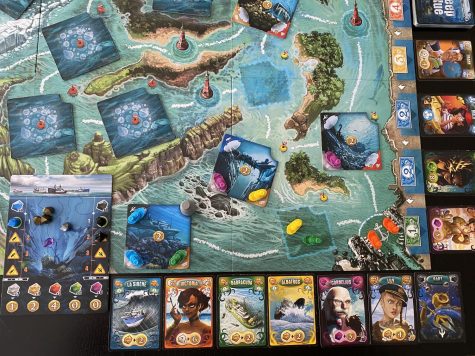
Some of the dive tiles that player will explore have a compass around the dive leader bonus, which marks that they are sunken city tiles. After a dive at a sunken city, the dive site is placed at a special location in the corner of the board. When players dive at all four of the sunken cities, the game ends immediately. Players add up the value of their victory coins, and the player with the most points is the winner.
The game also has seven captain scenario cards that affect sunken city dives. Players can choose to play one of them, and the card will have new rules that apply only to the four sunken city tiles.
Final Thoughts
The first thing everyone notices about Deep Blue is how beautiful the artwork is. The box cover is extremely detailed with little fish, a bright green treasure, shipwrecks, and other things above the water too. The game board is possibly the most beautiful board I’ve ever seen. The cards and dive sites are also nicely illustrated. My only slight negative with the components is that the silver and gold gems are hard to tell apart in certain lighting.
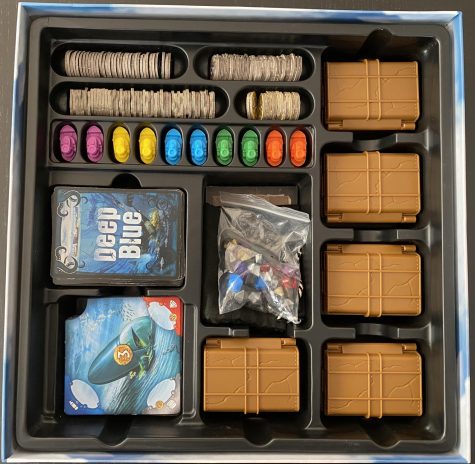
The next thing to remember is that Deep Blue is a push your luck game, meaning that players will be doing some luck-based action to get points and have to decide whether to try and increase the number of points they can earn or stop before they end up with no points. In Deep Blue, the luck of gem-pulling is exciting and interesting. There are a number of factors to consider as the dive leader because there are multiple ways to get points during the dive. You might want to keep pulling gems until you get a certain color because you have a card or scouting bonus for it, but you might also want to draw enough gems to encounter a hazard that only you can protect against.
That’s the second part of the push your luck aspect in Deep Blue. Unlike many games where player’s adventures are solo, Deep Blue involves other players. Players want to move their ships to the scouting bonuses or at least close enough to rush to the dives since being part of more dives means more opportunities to score points. However, the dives are less interesting and less rewarding when you aren’t the dive leader because you have no say in what happens. All it does is provide interesting choices for the dive leader to make. If you want to have those interesting choices, which is a big part of what makes the game fun, you have to find a way to lead some of the dives. Some people are bothered by this, but I’m not as phased by this because I have the mentality that I can try to crash your dive and maybe score more points than you in games where I am not going to be leading many dives.
The other mechanism in the game is engine-building. I like the cards that players can recruit in the game and how most of them give players multiple uses for them. The problem with the recruiting mechanism is that it isn’t important enough. I’ve played games where a player won by only recruiting zero or one crew member before racing to dive solo at the sunken city tiles. For a game that is largely about engine-building, I am quite disappointed that there is no motivation to actually build up an engine.
Firstly, think about whether it’s more fun to move your ships around the board and dive or to draw a card from the side of the board. The movement option appeals to more players because everyone wants to flip over a new dive site or claim a scouting bonus; fewer players prefer to sit patiently while piling up on crew member cards. It only takes one player to start racing before everyone is forced to follow suit even if they don’t want to.
Secondly, the rest action only gives players three of their discarded cards. This suggests that the ideal engine size is three cards, and players already start with four. If players can recruit a movement card, they can simply, move, dive, dive, rest, and repeat to quickly end the game. The value of the dive leader bonus becomes nearly unstoppable. Players who recruit more characters have to spend some time recruiting, then still have to move and dive. While their dives may be more rewarding, they will definitely get less of them since they have to spend two to three turns resting to get all their cards back.
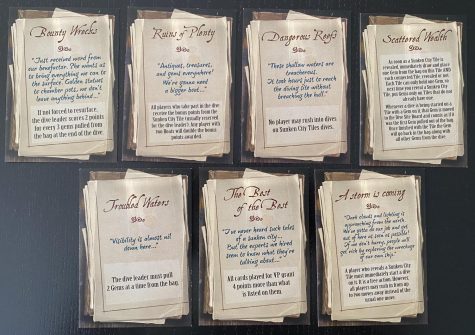
Since most games with this mechanism have players pick up all their cards when they rest, I assume that Deep Blue was originally play-tested where players retrieve all their cards. I’m sure the play-testers found something wrong with that, but I would be willing to try that rule change since it could possibly make recruiting more appealing. Another odd part of the recruiting action is paying four money to reset the characters and pick one. Nobody has ever done that in a game of Deep Blue, so I don’t know whether we all were missing something or whether it is just an extraneous rule that was left because it did no harm to the game.
This review may sound more negative than I mean it to because I do enjoy playing Deep Blue. It is a game that players have to enjoy for its beauty and fun while playing it and not for its balance or final scores. When I play, the game is the most fun when players ignore the idea of immediately racing their ships into the deep waters and recruit a few characters instead. I really like the captain scenario cards that change up the games in a small way. Many of them do encourage players to recruit, but some cards encourage players to move and dive as fast as they can.
In the end, this is a hard game to rate because it has gorgeous artwork, a nice theme, and good “push your luck” and engine-building ideas. However, the presence of the racing strategy and the limited rest action takes away from the recruitment aspect of the game and makes games less fun than they could otherwise be. For these reasons, I recommend Deep Blue to people who like or want to try “push your luck games” and care more about their gaming experience than the final scores. Speaking of final scores, Deep Blues’s final score is a 6.5 out of 10.
[star rating=”3.25″]



